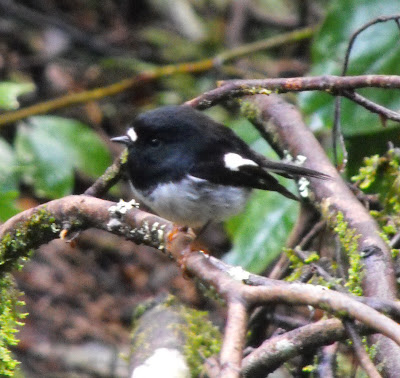Pirongia from Hamilton
There is a developing conservation awareness in Hamilton which probably relates to the small amount of indigenous environment that we have. Just over the hill a major long term effort is underway to reconstruct an entire lost ecosystem. Much further afield, another huge undertaking, the predator proof fencing and maintenance of an entire maunga, Maungatautari.Maungatautari tomtit
Maungatautari yellow fronted karakariki
It has not always been this way. In the early seventies, like many others, we built our first modest house. It was made largely of native timber, heart rimu and totara. Native timber was logged in those days so we played our part in the clear felling of an ancient N.I. forest and the destruction of all the organisms that lived within it. The pioneer ethic was stronger in those days and the balance between exploitation and conservation not so evident.Waikato basin from Maungakawa "halo site"
Native forest is now protected from the logging industry but the change was too late for the Waikato. Only 4% of natural endemic vegetation remains. An huge proportion of the rest is covered in a pastoral ecosystem transplanted from Europe and elsewhere. The wealth that this agribusiness creates contributes, in large part, to the economic well being of NZ. I am sure that many of the baches in the environmentally more favoured Coromandel have been funded from such a source.So, back to the Halo Project. Hamilton does present a much better environment for tuis than the surrounding, intensively managed countryside. The older parts of Hamilton are well treed, mostly exotics rather than natives, but these are acceptable to a number of native bird species. In some ways it is superior to Tuateawa in that the number of rats, possums and mustelids is low, although there are cats in very high density.
I have nothing but praise for the work of all the cooperating agencies and volunteer workers who, seeing the possibilities for Hamilton, put the Halo Project into operation. Some of those precious remaining areas of natural vegetation had their tui populations boosted through various conservation activities. It seems that tui will seek food as far as 20km. from home and many of them made the journey to Hamilton. They are now found in numbers in developed suburban areas and parks over Hamilton. There are some pairs and there is a great possibility of a resident breeding population becoming established.
Having few sizeable natural environments in the Waikato is partially compensated for by the lack of anti environmental activists. Conservation proceeds in a spirit of cooperation. The Robinsons contribute a little bit of negativity, mainly aimed at Environment Waikato but to little effect.
Generalisation is something to be avoided. However I believe it is fair to say that, where there is a largely intact environment there is a lesser environmental awareness and also a greater need to exploit the environment. High unemployment and low wages are more often found in such situations. Conservation activities which reduce the yield of possum fur, the halt to the logging of native timber, these all produce hardship for local people. Loss of jobs and the depression of the local economy inevitably build anti Govt. sentiment, particularly to those agencies of the local and national Govt. that are active in the area.
On the West Coast, when logging of native timber ceased it was natural that the Dept of Conservation would not be flavour of the week! The Govt. of the time did however recognise the consequences of the logging ban and provided seed money to develop other aspects of the local economy. Over time this proved to be a success.
In the Upper Coromandel there is significant anti conservation sentiment. It is ostensibly concentrated around the use of the conservation tool 1080. In reality the use of this compound does reduce the level of possums to a point where it is not possible to make a living from their fur. The anti conservation stance is understandable when conservation activity has such a financial impact on some individuals. However it is time to move on. The Westcoasters did and found new, less physically demanding, more financially rewarding ways of making a living. The Upper Coromandel is in a similar situation and in need of some Govt. capital to help it make the transition.
It is ironic that the anti conservation lobby probably destroyed the best opportunity for a prosperous future for the Upper Coromandel when they stymied the Peninsula Pestproof Fence at the last moment. Are views so entrenched that it could not be revisited? The region is really a National Park in waiting. It is scenically dramatic, has a diverse array of environments, great biodiversity and organisms found no where else in the world. Ecotourism is the coming thing internationally. Auckland is a major tourist hub and it is a short time by ferry from there to a landing spot like Paritu. What better ecoguide than a chap who is really familiar with the bush?
Change is overdue. It is time for the Upper Coromandel to catch up with the rest of the world. In it's own unique way of course. The way involves cooperation rather than confrontation. It worked in the Waikato and it can work in the Coromandel.







No comments:
Post a Comment